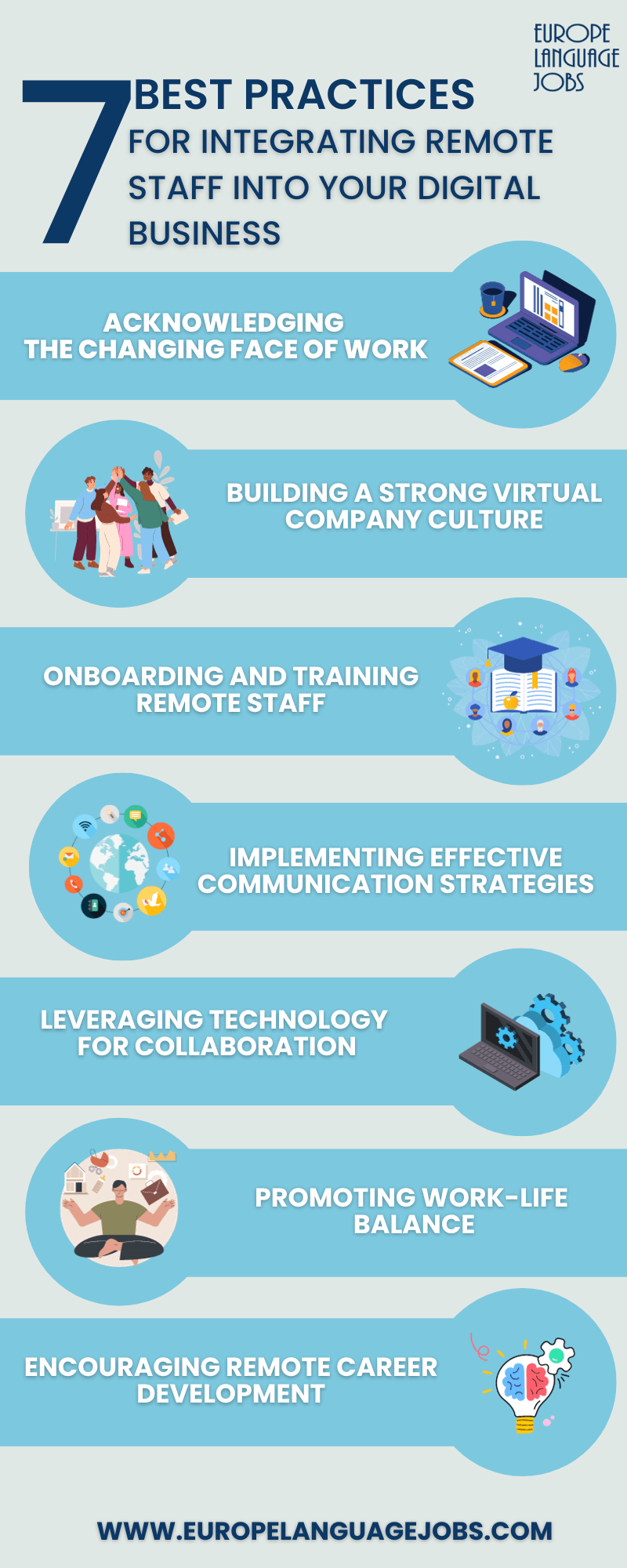In the dynamic realm of digital businesses, integrating remote staff is no longer a luxury but a necessity. This article explores effective strategies for harmonizing remote workers with digital enterprises, a task that extends beyond technology to encompass cultural and operational shifts. As traditional office boundaries fade, creating a cohesive, virtual work environment becomes essential.
We will dissect key areas such as fostering a strong virtual company culture, ensuring effective communication, and utilizing technology for seamless collaboration.
It's crucial that each remote employee feels not just connected but also an integral part of the team, despite the physical distance.
As we delve into the best practices for integrating remote staff, we're not just sharing strategies; we're providing a roadmap to weave these practices into the fabric of your digital business. Each section of this article is crafted to give you a comprehensive understanding of the essentials: from nurturing a robust virtual company culture to optimizing communication and leveraging the right technologies for collaboration.
In the following chapters, we’ll peel back the layers of remote work integration, examining each element with a keen eye. From the nuances of building a strong virtual culture to the practicalities of technology-driven collaboration, we aim to guide you through a transformational process.
Picture this as your map to a digital workplace where connectivity, productivity, and well-being coexist harmoniously, setting the stage for a deeper understanding of the dynamics that make remote work not just functional, but exceptional.
-
Onboarding and Training Remote Staff: A Multi-Faceted Approach
-
What Are Effective Communication Strategies for Remote Staff?


The Changing Face of Work
The landscape of work has undergone a seismic shift in recent years, marked by an unprecedented move towards remote work. A 2020 study by Gartner revealed that 74% of companies plan to permanently shift employees to remote work post-COVID-19. This statistic underscores a broader trend: the redefinition of the traditional workplace.
Remote work is not a mere stopgap but a fundamental change in how businesses operate, reshaping everything from daily workflows to long-term strategic planning. This shift is not just about location; it involves rethinking how we communicate, collaborate, and maintain productivity in a dispersed environment.
The benefits of this transition are multi-faceted:
-
Enhanced flexibility. Employees can tailor their work environments and schedules to suit their needs, leading to better work-life balance.
-
Increased productivity. Many organizations report higher productivity levels as employees spend less time commuting and more time focusing on work tasks.
-
Broader talent pool. Companies can tap into a global talent pool, so hiring a professional coder is no longer restricted by geographical limitations.
-
Cost savings. Both employers and employees can reduce costs related to office space, commuting, and related expenses.
This evolution towards remote work is not merely about adapting to change; it's about seizing the opportunity to create more dynamic, efficient, and employee-friendly workplaces.

Building a Strong Virtual Company Culture
In the digital era, where remote work is a norm, building a strong virtual company culture is not just beneficial but necessary.
Here are key strategies, expanded in detail, to cultivate such a culture:
-
Frequent communication: Regular communication is the cornerstone of a strong remote team. It's important to have a mix of formal and informal channels for team members to connect. Regular team meetings, one-on-one check-ins, and group chats for non-work-related discussions can help in maintaining the thread of connection and camaraderie.
-
Clear values and goals: Articulated company values and goals create a unified direction for remote teams. Establishing these and consistently referring back to them in all company communication helps remote employees align their daily activities with the broader company objectives, creating a sense of purpose and cohesion.
-
Virtual team building: To combat the sense of isolation in remote work, virtual team-building activities are essential. These can range from online team challenges to virtual coffee breaks where team members get to know each other on a personal level. Such activities help in building trust and understanding among team members.
-
Recognition and appreciation: Regularly recognizing and appreciating the efforts and achievements of remote employees is crucial. Whether it's through company-wide emails, newsletters, or during virtual meetings, celebrating successes and milestones contributes significantly to a positive company culture and employee morale.
-
Inclusive decision-making: Ensuring that all team members, regardless of their location, have a voice in decision-making processes is key to a healthy remote culture. This can be achieved through regular surveys, feedback sessions, or by including a diverse group of employees in planning meetings.
-
Training and development: Providing continuous learning opportunities is a vital part of keeping remote employees engaged. Online training sessions, e-learning courses, and virtual workshops for skill development show the company's commitment to its growth and adaptability.
By integrating these practices, companies can build a virtual company culture that is not only robust but also inclusive, fostering a sense of belonging and commitment among remote staff.

Onboarding and Training Remote Staff: A Multi-faceted Approach
When onboarding and training remote staff in a digital business environment, a comprehensive approach is crucial. As businesses expand their virtual operations, it becomes paramount to ensure that the onboarding process reflects both the technical demands of remote work and the values of the company.
Interestingly, the strategic evolution of various entities has lessons to offer in this context. For instance, strategic plans for universities exemplify how large, diverse institutions can evolve to meet changing demands.
Much like universities navigating the complexities of modern education, businesses too need robust, future-focused strategies to address the challenges and opportunities of remote work.
To effectively onboard and train remote staff:
-
In-depth digital inductions. Offer interactive sessions that introduce new hires to company ethos, policies, and the nuances of virtual teamwork.
-
Customized training modules. Acknowledging that every role and individual is unique, training should be tailored to meet specific needs and professional backgrounds.
-
Continuous feedback mechanisms. In a remote setup, regular touchpoints for feedback and support ensure that employees remain aligned with organizational goals.
-
Embracing digital mentorship. Pairing new hires with seasoned professionals in virtual mentorship programs can foster camaraderie and facilitate faster learning.
-
Tech competency assessments. Regularly gauge and train staff on technology tools vital to their roles, ensuring seamless performance.
Ultimately, successful onboarding and training in the remote era hinge on adaptability, foresight, and a commitment to continuous learning — attributes that can be inspired by entities like universities that have long mastered the art of evolving with the times.

What are Effective Communication Strategies for Remote Staff?
For digital businesses employing remote staff, adopting effective communication strategies is key to ensuring seamless operations and team cohesion. Here's a breakdown of the top strategies:
-
Regular check-ins: A cornerstone of effective remote work, regular check-ins, whether daily or weekly, keep everyone aligned and connected. As per Harvard Business Review, these check-ins boost team productivity and cohesion by keeping lines of communication open.
-
Utilization of diverse tools: Embracing a variety of communication tools addresses different needs – emails for formal communication, instant messaging for quick conversations, and video calls for in-depth discussions. This approach ensures every message finds its appropriate medium.
-
Established communication protocols: Clear guidelines on using different communication channels can greatly reduce misunderstandings. For instance, delineating what type of messages are suitable for emails versus instant messaging helps streamline communication.
-
Culture of feedback: Creating an environment where feedback is regularly exchanged can enhance clarity and foster continuous improvement. This also helps in addressing any communication barriers or issues on time.
-
Inclusivity in virtual meetings: Ensuring inclusivity in virtual meetings, where every team member has the chance to contribute, is vital. Scheduling meetings considerate of different time zones also plays a crucial role in fostering inclusivity.
-
Adoption of asynchronous communication: For teams spread across various time zones, asynchronous communication allows for a flexible exchange of ideas without the pressure of immediate responses. This not only respects individual working hours but also promotes a healthier work-life balance.
By implementing these strategies, digital businesses can navigate the complexities of remote communication, leading to a more connected, productive, and harmonious remote workforce.

Leveraging Technology for Collaboration
In the digital business arena, adeptly leveraging technology for remote staff collaboration is paramount. Central to this is adopting a unified collaboration platform, integrating messaging, file sharing, project management, webcam test, and video conferencing. This cohesive approach streamlines workflow, reduces tool-switching, and bolsters
Cloud-based solutions are instrumental in facilitating real-time collaboration. They allow for immediate document access, editing, and sharing, ensuring all team members have the latest information. Furthermore, project management tools are vital, helping to track projects, assign tasks, and manage deadlines. This ensures alignment and clarity of responsibilities within remote teams.
Integration capability is another critical factor. Technologies that mesh smoothly with existing systems enhance workflow efficiency and minimize technical issues. Equally important is security. Implementing strong security protocols, including secure logins and data encryption, is crucial for protecting shared sensitive information.
Key benefits of the right technology include:
-
Streamlined workflows. Making daily tasks more efficient and less time-consuming.
-
Enhanced communication. Ensuring clear, concise, and continuous interaction among team members.
-
Improved productivity. Facilitating faster and more effective collaboration.
-
Data security. Keeping sensitive information safe and secure.
In essence, the strategic selection and integration of technological tools can significantly enhance collaboration, driving productivity and success in remote work environments.

Promoting Work-Life Balance
In integrating remote staff into digital businesses, it's vital to prioritize work-life balance, an aspect pivotal to both employee well-being and overall productivity. The remote work environment, while flexible, often blurs the lines between personal and professional life, leading to potential burnout and decreased job satisfaction.
Key strategies to promote a healthy work-life balance include:
-
Clear boundaries. Establish and respect defined work hours. Encourage employees to disconnect post-work hours to rejuvenate and spend time with family or personal activities.
-
Flexible scheduling. Understand that remote work offers unique flexibility. Allowing staff to work during their most productive hours can lead to higher quality output and job satisfaction.
-
Mental health support. Provide access to resources like counseling services or mental health days. Regular check-ins can help address any concerns early on.
-
Regular breaks. Encourage taking short, regular breaks throughout the day to reduce screen fatigue and maintain high energy levels.
-
Encourage physical activity. Promote a culture that values physical health, suggesting activities like virtual fitness challenges or providing subscriptions to online exercise platforms.
Valuing and promoting work-life balance is a strategic approach to maintaining a happy and efficient remote workforce.

Encouraging Remote Career Development
In the digital business realm, integrating remote staff not only involves managing their current roles but also nurturing their career development. Despite the physical distance, it's imperative to create growth opportunities that are equally accessible to remote employees.
Firstly, providing access to continuous learning resources is essential. This includes online courses, webinars, and virtual workshops that cater to diverse skill sets and career aspirations. By facilitating educational opportunities, businesses can help remote staff stay current with industry trends and technological advancements.
Mentorship programs tailored for remote settings are another powerful tool. Pairing remote employees with experienced mentors, either within or outside the organization, can foster professional growth and offer valuable guidance.
Performance reviews and feedback sessions also play a crucial role. Conducting regular, constructive performance evaluations helps remote staff understand their progress, identify areas for improvement, and set clear goals for their career trajectory.
Finally, recognizing and rewarding achievements is vital. Celebrating milestones, whether through public acknowledgement or career advancement opportunities, boosts morale and reinforces a culture of growth and recognition.
Overall, by investing in these areas, businesses can ensure that remote employees feel valued and have clear pathways for career progression, which is key to retention and overall job satisfaction.
Conclusion
Integrating remote staff into digital businesses marks a transformative shift in the workforce. This transition, extending beyond technical adaptations, demands a comprehensive approach that envelops cultural, communication, and developmental facets.
Key strategies include cultivating a robust virtual company culture, implementing effective communication techniques, and leveraging technology for seamless collaboration.
Additionally, thoughtful onboarding and training, integrated with strategic plans for universities, facilitate smoother transitions for remote staff. Prioritizing work-life balance and career development is also crucial for sustained engagement and satisfaction.
Ultimately, successful integration transcends geographical barriers, fostering an environment where productivity, innovation, and employee fulfillment flourish. As businesses adapt to these shifts, embracing these practices becomes vital for thriving in the dynamic landscape of digital business.




















Hamza Hanif 1y ago
Great article! Your tips for integrating remote staff into digital businesses are spot-on. Clear goals, communication tools, and work-life balance are crucial. Thanks for sharing these valuable insights! Check out this plugin as well: https://postmansmtp.com/
Great article! Your tips for integrating remote staff into digital businesses are spot-on. Clear goals, communication tools, and work-life balance are crucial. Thanks for sharing these valuable insights! Check out this plugin as well: https://postmansmtp.com/